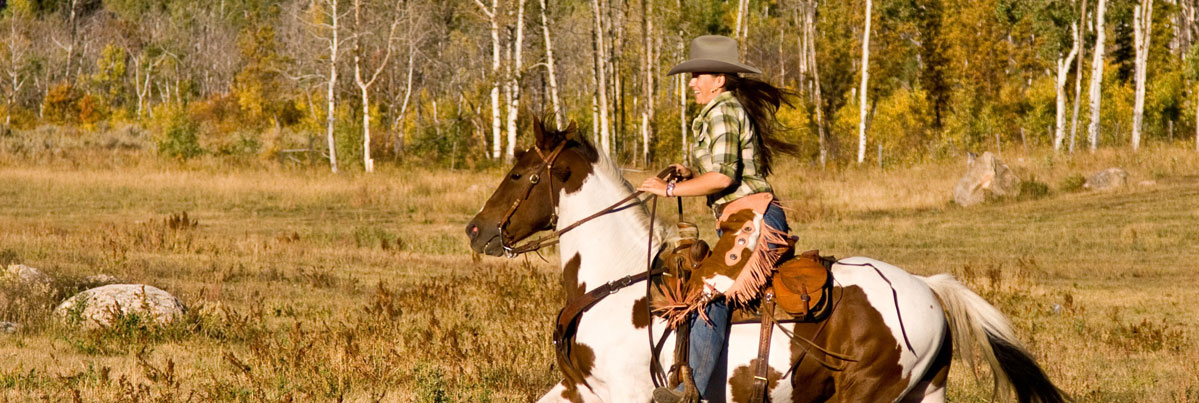
THE FELTING PROCESS
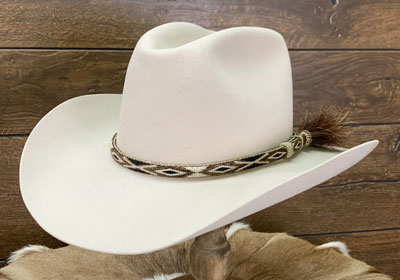 It is probable that most people think of felt as a kind of cloth, smoother and tougher than cotton or woolen fabric, but cloth nevertheless. The fact is that there is no likeness what so ever in the principles of production between felted fabric and woven fabric.
It is probable that most people think of felt as a kind of cloth, smoother and tougher than cotton or woolen fabric, but cloth nevertheless. The fact is that there is no likeness what so ever in the principles of production between felted fabric and woven fabric.
Felt differs from every other fabric in that it is made of a myriad of short, single animal fibers which are interlocked by their natural tendency to ”crawl” and twist when kneaded and manipulated in hot water and steam. Felt is the strongest fabric known because every fiber is interlocked in every direction with a number of other fibers. All other fabrics are made of fibers, which are first twisted into threads and then woven by hand or machine. As these threads are always woven either in right angle or parallel lines, the woven fabric may be torn apart along a straight line.
Felt can be made into one of the smoothest fabrics known, once again because it is made of tiny single fibers interlocking in every direction rather than groups of twisted fibers woven in a straight line. Felt is the lightest fabric known, in relation to its tensile strength, because a minimum of fibers is required to make the requisite toughness. Felt is the most resilient of fabrics, for the same reason. Felt is more impervious to water than any other fabric, because of the close interlocking of its fibers and because the animal fibers themselves do not soak up moisture.
Felt hats can be made from either fur felt (medium or high price) or wool felt (low price).
Fur felt hats are chiefly made of rabbit fur. Some hare fur is used to make better hats, and is often mixed with beaver fur to produce hats in various medium price grades. Beaver, the finest fur, and chinchilla is usually used in the best hats.
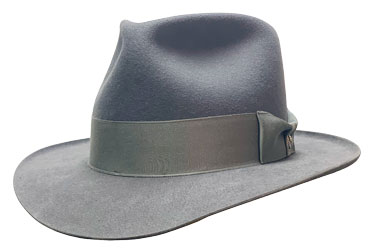 By using the word ”fur,” it is meant the downy under-fur of these animals not the long, coarse hair that is commonly called fur. Only this under-fur has the barb-like projections on the surface of each fiber that will lock the fibers together to make a strong felt.
By using the word ”fur,” it is meant the downy under-fur of these animals not the long, coarse hair that is commonly called fur. Only this under-fur has the barb-like projections on the surface of each fiber that will lock the fibers together to make a strong felt.
The long hairs are pulled out or sheared off. The remaining under-fur is carefully treated to raise up the microscopic barbs for better felting.
Fur felt hats are superior in lightness of weight, mellowness to the touch, and ability to keep their shape and withstand weather and renovating.
A good fur blend is a proper combination of large and small fibers to produce the texture wanted. So much long stock is needed to give a good rate and quality of felting and so much short stock to fill the interstices, thus imparting smoothness and compactness. As many as eight different types of grades of fur may enter into a single fur mixture, depending on the price of the hat, the color to which it is to be dyed, etc.
The bagged fur 1s delivered to the hat manufacturer must undergo several mixing and refining processes before it is ready to be formed into hat bodies. After mixing, the fur has assumed a mottled grayish color, and the original furs entering the mixture can be seen only with the greatest difficulty.
Mixed fur is then ”blown”, a process which removes clotted fur, air, and dirt. Fur coming out at the delivery end of this process resembles an endless sheet of gray absorbent cotton, soft, light, and downy.
There are two main steps in making fur into a hat. First, the fur is made into a large, loose cone, and then this cone is shrunk and shaped into a finished hat.
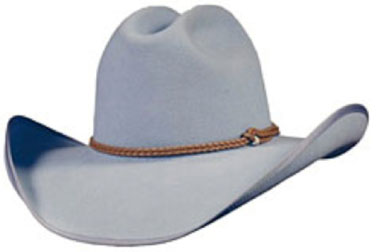 Forming the cone is really the key to felt hat making. It is done in a forming machine. Picture an upright, cylindrical compartment, and inside this compartment, on the floor, a copper cone about 3 feet high, points upward. This cone revolves slowly. It is perforated, and an exhaust fan beneath it sucks the air, and the loose fur, in the chamber down to the cone.
Forming the cone is really the key to felt hat making. It is done in a forming machine. Picture an upright, cylindrical compartment, and inside this compartment, on the floor, a copper cone about 3 feet high, points upward. This cone revolves slowly. It is perforated, and an exhaust fan beneath it sucks the air, and the loose fur, in the chamber down to the cone.
Fur for one hat is weighed out and drawn into the top of the forming chamber. Sucked downward by the exhaust fan, it settles on the revolving cone. The fibers are inter-tangled every which way, but only loosely, the fragile layer of fur could be brushed off with one’s finger. The operator carefully wraps damp burlap cloths’ around the cone and then immerses it for a short time in a vat of hot water. That’s when the felting starts. The hot water shrinks the fibers just a little, but yet enough to knot them into a flimsy layer of felt.
The layer of felt is stripped from the cone. It is several times the height of the finished hat, and so delicate that it must be handled with the utmost care.
Now the shrinking is begun in earnest, until the body is felted down successively from its original huge dimensions to its final size.
The body is folded, dipped in hot water, and rolled with pressure. From time to time, it is opened, examined, and if satisfactory, again folded, dipped, rolled and pressed. Under the action of the hot water and the manipulation, the fibers shrink, their projecting barbs locking together tighter and tighter until the cone is no bigger than the finished hat, it is so tightly felted that a strong man cannot pull it apart.
This is hard and painstaking work, and must be done rapidly, or the bodies will cool off, and poor felt will result.
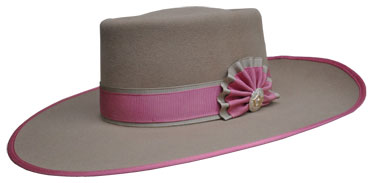 Although machines play a part in this process, more in the lower and medium grade, than in the fine grades, much shrinking is done by hand, especially during the early stages when the cone is large and extremely delicate.
Although machines play a part in this process, more in the lower and medium grade, than in the fine grades, much shrinking is done by hand, especially during the early stages when the cone is large and extremely delicate.
Machines that do the shrinking are ”rollers,” like big wash wringers. The bodies are wrapped in cloths and passed through the rollers, over which hot water is pouring. Thus hand rolling is mechanically stimulated.
A trained worker, however, must always be on hand to wrap the bodies expertly, inspect them frequently, and adjust the rollers. Even the forming machine requires a highly skilled operator to control the currents within the machine so that the fur is perfectly distributed on the cone.
A rough shape is obtained by stretching the finished shape by blocking the crown and flanging the brim. Crown stretching is done on a machine which has a frame over which the cone is placed, and above this, metal fingers. The fingers ”massage” the tip of the cone, pressing the felt between the rib of the frame, thereby stretching it. The brim stretcher grips the brim with metal fingers and works on the same principle.
The hat is roughly blocked into shape by wetting it and pulling it over a wooden block. Blocking to final size is done with steam and an iron.
Wood used in the blocks comes from the American poplar tree, which is better than other woods because it has no grain or hard or soft streaks in the better grades. Therefore, when felt is pressed on a poplar block, the shape of the wood texture does not show.
BLOCKING HATS
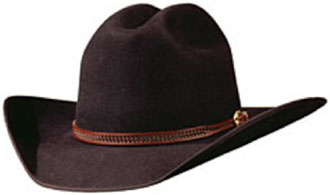 The original block is made by hand and the rest by machines, which duplicate the original. The hat manufacturer must have not only a set of blocks for each style, but also a set of blocks for every head size in which the style is to be made. A large factory must have a number of sets of each popular style block so that more than one workman can assist in turning out orders.
The original block is made by hand and the rest by machines, which duplicate the original. The hat manufacturer must have not only a set of blocks for each style, but also a set of blocks for every head size in which the style is to be made. A large factory must have a number of sets of each popular style block so that more than one workman can assist in turning out orders.
Setting the brim in the hat manufacturing process is called flanging. First the brim is ironed flat, and cut to a specific width. Then it is curled and laid on a wooden flange of desired roll, iron again and finally dried and pressed, while still on the flange, with a sandbag such as you see in renovating shops.
From the time the body is formed until it is blocked, the hat gets a lot of careful treatment besides the steps outlined here. It is dyed, a difficult technical job, usually carried out in an early stage of felting; the brim is impregnated with just the right degree of stiffening shellac to make it hold up, the entire hat is rubbed with sandpaper many times, the number depending upon the smoothness sought.
Finally, the hat is trimmed the leather, lining and band sewed on, all of which must be done with care because the workmanship shows.
THE LEATHER MAKER’S ART
Skins for hat leather are divided into two classes, roans and skivers. The roan is the whole skin with none of the flesh side shaved off. The skiver is a skin that’s been split into two, with only the outer or grain side used for hat leathers. The other side, or flesh side, is generally made into chamois leather.
Roans, with their mellow plumpness and tensile strength, go into better hats. Skivers are usually reserved for the medium to lower grades of headwear. They are also used where lightweight is a prime requirement. More than 25 distinct operations are required to transform the raw skin into the finished product.
Quality cannot be discerned entirely from appearance. The leather’s built-in goodness shows up later on, when it is on the head of the customer.
CUT BY HAND
Since hat sweat shapes vary for different types of hats, cutting must be done by hand. First the cutter selects one of many steel-faced wood patterns along which the knife is to cut. With varying ”scopes” (the curve from front to back) on different crown blocks, the cutter must use a great variety of wooden patterns on his job, so that he can cut leathers which will exactly fit the blocking of a particular style of hat.
The finished sweat is sent to the hat manufacturer. There the two ends of the leather are sewn together, and a small bow attached by hand at the top of the joint. The sweat is then machine-sewed into the hat. The bow adds a decorative touch to the inside of the hat, but also has a functional use: it tells the wearer which is the back of the hat. It also indicates to the retail salesman the exact center of the hat, so that he has a mark to guide him in creasing the crown.
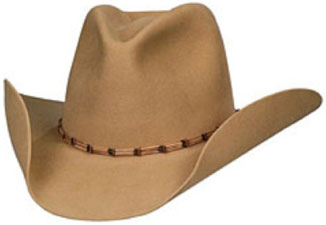 Sometimes, for added appearance and comfort, the leather is reeded. A resilient synthetic thread (in the old days and actual rattan reed was used) is encased in hatter’s glaze and, together with an oiled silk insert, is sewn to the leather at the base of the brim, which one’s forehead always touches.
Sometimes, for added appearance and comfort, the leather is reeded. A resilient synthetic thread (in the old days and actual rattan reed was used) is encased in hatter’s glaze and, together with an oiled silk insert, is sewn to the leather at the base of the brim, which one’s forehead always touches.
A reeded leather is plumper looking and cushions the head better; the oil-silk underneath is added protection against perspiration staining the felt. Although reeding a leather adds to the cost, it is important to remember that the leather is the most important of hat trimmings, because it is the only part of the completed hat that touches the head.
Unless the leather is soft, well fitted and absorbent, the wearer will never fully enjoy his hat. Appearance counts too.
Most hat leathers are made from sheep and lamb skin. These skins are shipped to the U.S. from widely scattered lands, in addition to a sizeable domestic production.
Sheep and lambskin are used for hat leathers because they have the requisite properties. They are open textured, and thus readily absorb perspiration. At the same time they are neither too soft nor too stiff nor too porous.
While calfskin also makes fine hat leather, its high cost is a deterrent to widespread use in hats.
Synthetic leathers are frequently used in lower-priced hats. Thanks to modern improvements in synthetics they give the wearer quite a lot of the qualities of leather for the price.
Gross grain ribbon or other fabric is sometimes used for hat sweats where extreme lightweight and rollability are a factor.
THE NEW FOAM SWEATS
A new principle of hat sweats has recently been introduced, consisting of a bond of plastic or rubber foam, with fabric facing laminated on the side next to the head. It provides a yielding cushioned fit, and in some degree takes care of slight variations in head size.
Now a further application of the idea has produced a revolutionary ”stretch sweatband”, which not only stretches, a with goods cut on the bias, but elastically springs back to softly cling to the head for the life of the hat. It is done by use of new stretch fibers derived from the garment trades. In effect, it takes care of two sizes per hat, permitting smaller size range in retail stock. It also helps fit the troublesome between-size head, enables better fitting by the novice salesman, and keeps the hat from being blown off by the wind.
HAT LININGS
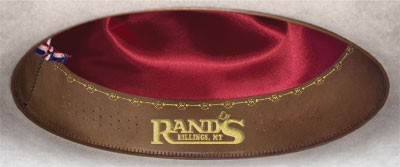 A fine, lustrous lining tempts the customer to buy. The unlined hat has no mystery, it is fur inside and out, and the whole can be seen immediately. With a lining, all is not evident to the eye. And the purchaser gets a feeling of luxury and hidden value, as with a richly lined coat. From the dealers view point there is another advantage. A lining with the dealer’s trademark emblazoned on it, is an attention getting, inexpensive, and long-lived method of advertising. Linings of good hats are made of fine satin.
A fine, lustrous lining tempts the customer to buy. The unlined hat has no mystery, it is fur inside and out, and the whole can be seen immediately. With a lining, all is not evident to the eye. And the purchaser gets a feeling of luxury and hidden value, as with a richly lined coat. From the dealers view point there is another advantage. A lining with the dealer’s trademark emblazoned on it, is an attention getting, inexpensive, and long-lived method of advertising. Linings of good hats are made of fine satin.
GREASE PREVENTION
Grease prevention tips are sometimes attached to the regular crown lining to protect it and the crown of the hat from hair oil and perspiration. Originally oiled silk was used exclusively, but cellophane, pliofilm and transparent rayon have all been found suitable.
LININGS STAY IN
What make the lining stay put? Since most linings even in the finest of hats are basted only at the bottom edge, this question is often asked. There is one principal answer. Linings are exactly tailored to fit the hats into which they are to be fit for. Skilled workers do the inserting. Careless or inept work can spoil the interior appearance of the hat. This also adds to cost.
INDIVIDUAL LININGS
For the best grades of hats individual linings are made not only for each head size, but also for each crown height. For other hats one lining is sometimes used for two different crown heights, if these do not differ by more than ¼ of an inch. The sweatband conceals the slight variance. In a well done lining and hat assembly the seam in the lining (if a straight seam is used) should line up with the joint in the sweat and with the center of the die in the tip.
BRIM EDGING
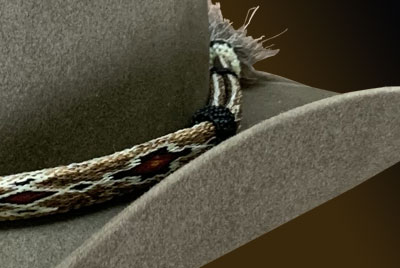 The original block is made by hand and the rest by machines, which duplicate the original. The hat manufacturer must have not only a set of blocks for each style, but also a set of blocks for every head size in which the style is to be made. A large factory must have a number of sets of each popular style block so that more than one workman can assist in turning out orders.
The original block is made by hand and the rest by machines, which duplicate the original. The hat manufacturer must have not only a set of blocks for each style, but also a set of blocks for every head size in which the style is to be made. A large factory must have a number of sets of each popular style block so that more than one workman can assist in turning out orders.
THE BOUND EDGE
Functionally, a binding exerts a tension on the brim, which helps the brim to hold its shape. It also helps to keep the brim edge even, without rippling or buckling. Decoratively, a bound brim serves to dress up the hat, influence its color effect, and suggest special, deluxe treatment. As in the case of the band, the color and width of the binding are an important part of a hat’s general effect. A wide binding will tend to make the brim look wider. In the matter of color, a light contrast binding on a dark hat will make the hat seem lighter. Likewise, a neutral binding on a bright hat will tone it down; while a lighter, brighter color binding on a neutral body will help to emphasize the color of the hat.
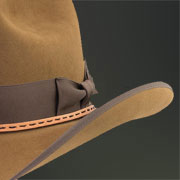 There are three general types of ribbon bindings on hats. The binding may be the same width on the top and bottom of the brim, or may be narrower either on the top or bottom. The hat manufacturer chooses according to the style effect he wishes to create. It should be noted that an uneven binding adds to the cost of the hat by requiring two sewing operations. Several types of stitching are employed to attach the binding to the brim. One is the regular or through stitch which is visible on the outer side of the rolled brim. Then there is the purely ornamental stitch, such as the saddle stitch, really an imitation hand stitch made by the sewing machine. Finally, there is the genuine had sewed binding, a beautiful trim put on by the hands of specially trained workers. It is a tedious and painstaking job.
There are three general types of ribbon bindings on hats. The binding may be the same width on the top and bottom of the brim, or may be narrower either on the top or bottom. The hat manufacturer chooses according to the style effect he wishes to create. It should be noted that an uneven binding adds to the cost of the hat by requiring two sewing operations. Several types of stitching are employed to attach the binding to the brim. One is the regular or through stitch which is visible on the outer side of the rolled brim. Then there is the purely ornamental stitch, such as the saddle stitch, really an imitation hand stitch made by the sewing machine. Finally, there is the genuine had sewed binding, a beautiful trim put on by the hands of specially trained workers. It is a tedious and painstaking job.
Like a ribbon binding, a welt edge on a hat brim gives firmness to the edge and helps it hold its shape better and longer. It also makes the edge thicker and better able to withstand the daily handling to which it is subject. Like a binding, it dresses up the hat and adds a note of distinction. Fundamentally, a welt edge is simply part of the brim turned on itself and so fixed as to stay in place. The turned back part may be on the underside of the brim, when it is termed an under welt.